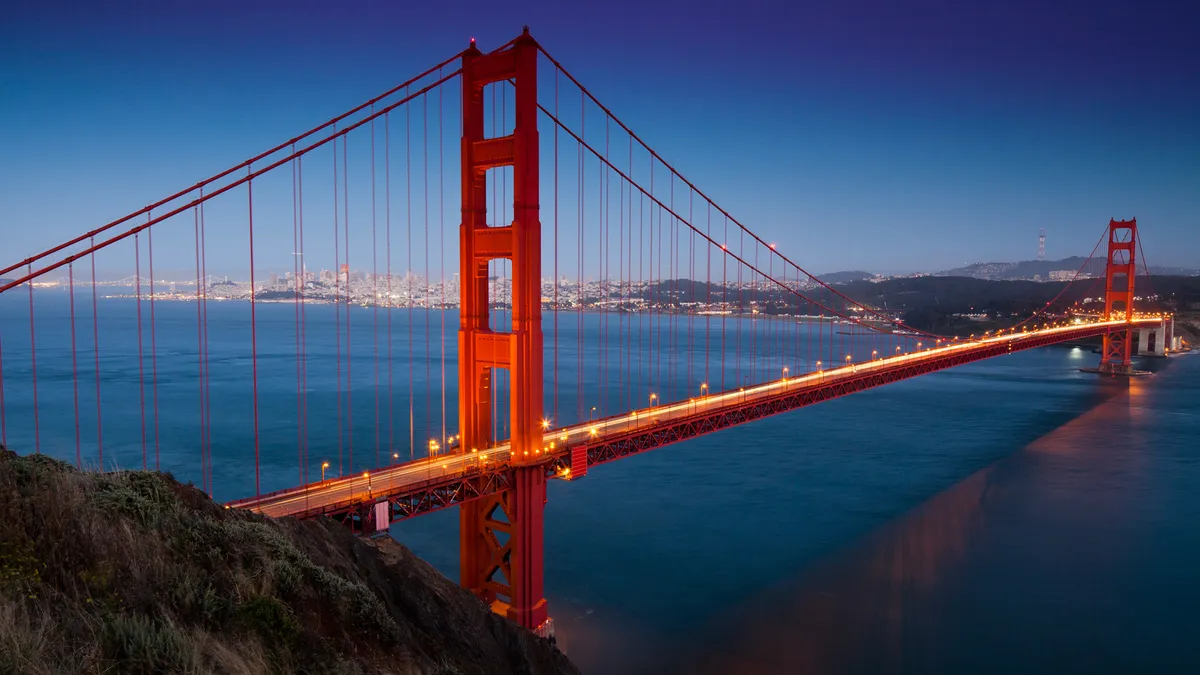Dive Brief:
- San Francisco has become the first large city in the United States to require new buildings install solar energy, a move the city undertook as a way to meet its 100% renewable energy goal, NPR reports.
- The legislation is backed by the San Francisco Commission on the Environment, the U.S. Green Buildings Council, the Building Inspection Commission, and sustainability non-profit Brightline Defense.
- The measure builds on California’s Title 24 Energy Standards, which require new buildings to set 15% of roof area aside for solar installations. The new law applies to all new residential and commercial buildings of 10 floors or less.
Dive Insight:
San Francisco is one of a few cities around the country looking to go 100% renewable, but a new law passed unanimously by the city's Board of Supervisors underscores how serious it is about the goal. Mid-sized commercial and residential construction will now have to do more than set aside roof-space for possible solar installations: Building developers will, by law, have to install some form of solar energy.
“By increasing our use of solar power, San Francisco is once again leading the nation in the fight against climate change and the reduction of our reliance on fossil fuels,” said San Francisco Supervisor Scott Wiener, who also introduced the measure. “Activating underutilized roof space is a smart and efficient way to promote the use of solar energy and improve our environment. We need to continue to pursue aggressive renewable energy policies to ensure a sustainable future for our city and our region.”
San Francisco will be the first major city in the country to require solar to be installed on new construction. The Department of the Environment and the Environment Commission were tapped to support and create programs that move the new policy forward.
But the new ordinance's impact is uncertain, and some media outlets are casting doubt on the new measure. Engadget points out that "this could just be seen as political grandstanding. The number of sub-10-floor buildings going up in San Francisco is pretty low, especially in terms of residential construction."
And Fortune notes that San Francisco is already a city where development is difficult, and the new ordinance will only complicate that.
"While many will cheer San Francisco’s new clean energy rule, it’s also the latest rule that developers in the city will face when constructing new buildings," Fortune reports. "San Francisco is a notoriously difficult place to develop in, leading to a shortage of housing and real estate for its expanding population."
The ordinance focuses on climate change and San Francisco's precarious location.
"As a coastal city located on the tip of a peninsula, San Francisco is vulnerable to sea level rise, and human activities releasing greenhouse gases into the atmosphere cause increases in worldwide average temperature, which contribute to melting of glaciers and thermal expansion of ocean water – resulting in rising sea levels," the ordinance reads.
San Francisco's goals include a greenhouse gas-free electric system by 2030 and reducing greenhouse gas emissions citywide to 40% below 1990 levels by 2025, and 80% by 2050.
"San Francisco is already experiencing the repercussions of excessive CO2 emissions as rising sea levels threaten the city’s shoreline and infrastructure, have caused significant erosion, increased impacts to infrastructure during extreme tides, and have caused the city to expend funds to modify the sewer system," the ordinance said. "Some people in San Francisco, such as the elderly, may be particularly vulnerable to higher temperatures resulting from climate changes."















